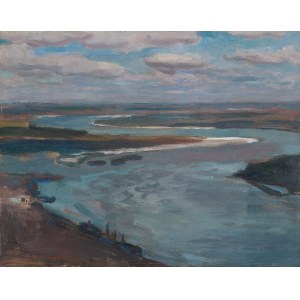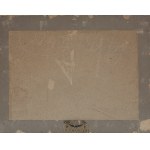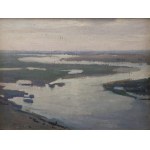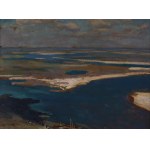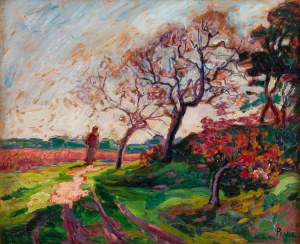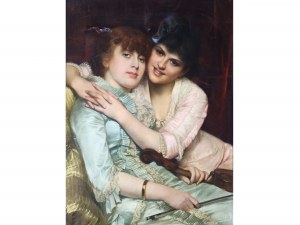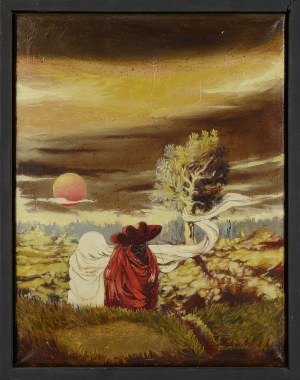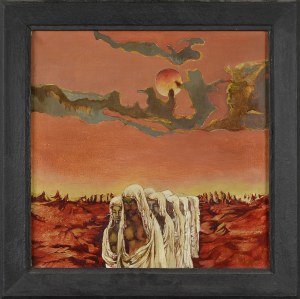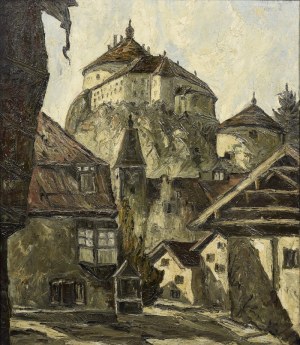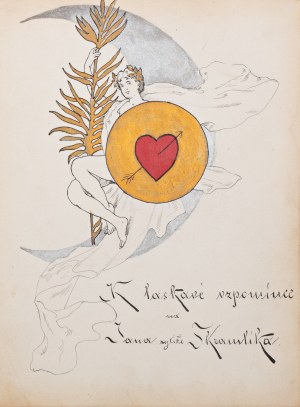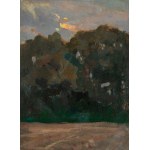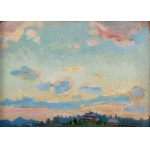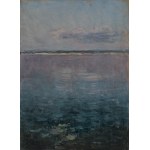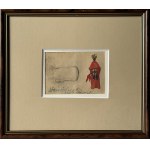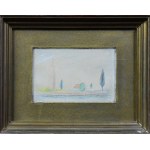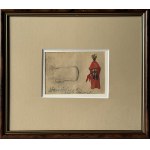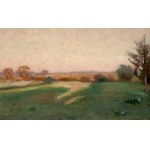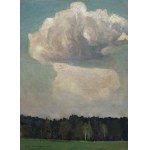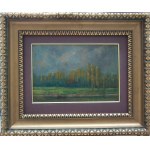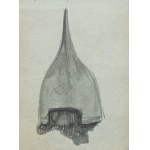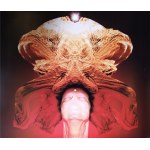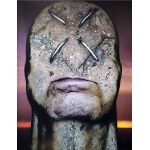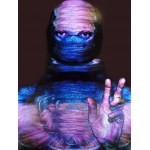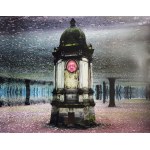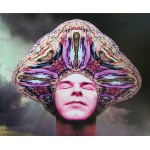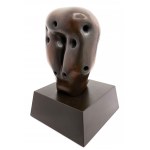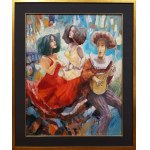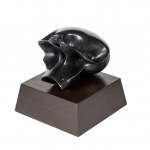23.8 x 30.8 cm - oil, cardboard signed l.d.: JAN STANISŁAWSKI
On the back l.g. number (in pink crayon): 224 [in circle]; next to it (in blue crayon): Dr. Loew;
l.d., opposite composition (in pencil): 3803; also, at the bottom, a sticker of the framing establishment M. Tramier.
The painting is accompanied by an expert's report by Dr. Stefania Krzysztofowicz-Kozakowska dated May 2023.
Around 1900, the painter's oeuvre intensified his tendency to synthesize landscapes and views of the Dnieper River became an important subject at the time. The artist repeatedly returned to Kiev, where he visited his mother, who lived there, and on occasion painted an almost impressionistic series of Dnieper landscapes from an identical point. The Dnieper River fascinated Jan Stanislavsky. He returned to it many times to observe its banks, meanders and limans at different times of the day and year, in cloudy and sunny weather; almost impressionistically registering in successive compositions the changes occurring in the colors of the river or in the play of light on the water surface. Once the Dnieper was a sapphire ribbon swirling against a background of sandbanks, at other times it took on the color of ochre, purple or brown reflecting the terror of the river. The result was a series of small landscapes - "songs of nature" - in which the meandering river and its colors, dominated by deep sapphires, violets, ochres, sky blues contrasting with the whiteness of the sandbanks and gently harmonizing with the greens, violets or ochres of the coastal dried meadows, took the leading role. In the views from the Danube - studies of the interplay of water, light and air, initially realistic, with time becoming more and more synthetic - as Zenon Przesmycki wrote - there was more and more flickering of elusive, otherworldly - one might say, metaphysical elements and accents; bold stylizations of lines and transpositions of colors sometimes reached as far as purely rhythmic essences of nature, as far as mysteriously symbolic (!) meanings. The Dnieper itself, which has its place in both Polish history and literature, is also not without significance in the symbolic reading of these compositions.
The main series of depictions of the Dnieper was created around 1903. The presented composition belongs to it. Most were painted from the same spot. Identical views can be found, for example, in works from the collection of the National Museum in Cracow: blue Dnieper (see opposite) from around 1904 (from the collection of Feliks Manggha Jasinski), sapphire Dnieper, from around 1904. The closest to our landscape is Dnieper (Limans of the Dnieper at Dawn), 1903 (see opposite).
According to the expert opinion of Dr. Stefania Krzysztofowicz-Kozakowska
Jan Stanislawski (Olshana in Ukraine 1860 - Krakow 1907) - an outstanding landscape painter, printmaker and educator - was one of the most colorful figures of the Krakow artistic milieu of the Young Poland era.
Initially in Warsaw and St. Petersburg, he studied mathematics, then painting under Wojciech Gerson in Warsaw, Władysław Łuszczkiewicz at the Cracow School of Fine Arts, and in 1885-1888 under Carolus Duran in Paris. He traveled extensively in Europe - he went to France, Italy, Spain, Switzerland, Germany, Austria, the Czech Republic, and traveled to Ukraine many times. In 1895 he was in Berlin, where he collaborated with W. Kossak and J. Fałat in painting the Berezina panorama. In 1897 he became a professor of landscape painting at the Cracow School of Fine Arts, the creator of the so-called Cracow School of Landscape. He educated nearly 60 students, including S. Kamocki, H. Szczygliński, S. Filipkiewicz, I. Trusz and S. Galek. He was one of the founders of the Society of Polish Artists Art (1897), a member of the Society of Polish Applied Art (1901). He participated in many exhibitions.
Initially, he painted realistic landscapes based on preparatory studies from nature (numerous surviving sketchbooks). His later fascination with Impressionism led to experiments with light in landscapes and an increasing desire to synthesize color forms. During his travels, he created hundreds, mostly miniature landscapes painted directly in the open air. He worked in printmaking, illustration, and designed posters and theater decorations.
Recently viewed
Please log in to see lots list
Favourites
Please log in to see lots list



